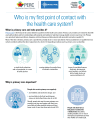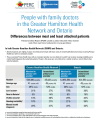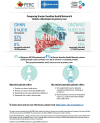Am I attached? A patient-partnered approach to creating infographics about attachment to primary care in Ontario, Canada
- PMID: 39497223
- PMCID: PMC11533307
- DOI: 10.1186/s40900-024-00652-5
Am I attached? A patient-partnered approach to creating infographics about attachment to primary care in Ontario, Canada
Abstract
Background: Having a primary care provider is associated with better care experiences and lower care costs. In 2021, INSPIRE-PHC released Primary Care Data Reports - publicly available summaries of administrative billing data about how populations in each of Ontario's 60 health teams use primary care services. Given the characterization of Canadian primary care systems as 'in crisis', publicly available data about primary care at the regional level presented a significant opportunity for knowledge mobilization. An understandable resource could ground the public conversation about primary care access in data. Recognizing the role that lived experience plays in ensuring the public understands research findings, a partnership between patient advisors, Ontario Health Team representatives, researchers, and trainees was established to co-produce public-facing infographics based on primary care data.
Methods: Evidence-based guidelines for public health infographic creation and elements of transformative action research guided a six-meeting process to engage up to 14 patient advisors, three Ontario Health Team staff and two primary care trainees. Patient advisors were affiliated with a provincial patient-oriented primary health care research group or a Hamilton-based Ontario Health Team. Ninety-minute meetings were conducted virtually, and notes were shared with attendees to ensure they accurately reflected the conversation. Two consultations with Ontario Health Team-affiliated primary care providers provided direction and ensured project outputs aligned with local priorities.
Results: Project partners shared feedback on draft infographics, audience identification, priority elements from Primary Care Data Reports to include in the infographics, and aesthetic features (e.g., headings, colour scheme, charts). Project partners felt the most important metrics to convey to the public were those that simultaneously reinforced the benefits of primary care on individual health outcomes and health system costs.
Conclusions: Patient engagement in research is becoming widespread, but co-developing knowledge products with patient and health system partners is less common. Our approach to engaging patients prevented both oversimplification and unnecessary complexity in a public-facing visual about attachment to primary care.
Keywords: Big data; Community-based participatory research; Health communication; Health services research; Patient and public involvement; Patient engagement; Patient partner; Primary care research; Primary health care.
Plain language summary
Primary care is the first point of contact for patients accessing the health care system. Primary care providers (i.e., family doctors and nurse practitioners – working individually or in teams of nurses, dieticians, pharmacists, social workers and others) – help patients and families manage health concerns over time by working to prevent, diagnose, and treat illnesses and link patients with specialist care when needed. Having a primary care provider is associated with better healthcare experiences and lower costs of care. In 2021, the Primary Care Data Reports were released to the public. The reports contain administrative data about how patients engage with primary care in each of the 58 Ontario Health Teams. Patient advisors, Ontario Health Team representatives, researchers, and trainees created an infographic to share this data in a way that can be understood by everyone. Infographics use images to help people process information faster, which can make health-related topics easier to understand. By understanding the value of primary care, people can participate in conversations about how to ensure primary care is accessible to everyone. Engaging patients is becoming common in research, but collaborating with patient advisors and health system partners to create visual summaries is less common. We had six virtual meetings that were 90 min each with up to 14 patient advisors, Ontario Health Team representatives, researchers and trainees. Patient advisors helped decide who the audience would be, which information from the Primary Care Data Reports to include, and how the infographic would look. Patient advisors felt it was most important to highlight the benefits patients can get from primary care, and the impact primary care can have to reduce health system costs. We consulted with primary care clinicians to ensure the infographic reflected local priorities. Working with patient advisors and Ontario Health Team representatives helped to create an infographic about Primary Care Data Reports data that is easy to understand by the public.
© 2024. The Author(s).
Conflict of interest statement
The authors declare no competing interests.
Figures





Similar articles
-
The value of involving patients and public in health services research and evaluation: a qualitative study.Res Involv Engagem. 2021 Jun 29;7(1):49. doi: 10.1186/s40900-021-00289-8. Res Involv Engagem. 2021. PMID: 34187590 Free PMC article.
-
The INSCHOOL project: showcasing participatory qualitative methods derived from patient and public involvement and engagement (PPIE) work with young people with long-term health conditions.Res Involv Engagem. 2023 Oct 12;9(1):91. doi: 10.1186/s40900-023-00496-5. Res Involv Engagem. 2023. PMID: 37828630 Free PMC article.
-
Encouraging diversity in family engagement in research: Reflections on the development of knowledge translation tools.Res Involv Engagem. 2023 Oct 13;9(1):94. doi: 10.1186/s40900-023-00486-7. Res Involv Engagem. 2023. PMID: 37833758 Free PMC article.
-
Digital First Primary Care for those with multiple long-term conditions: a rapid review of the views of stakeholders.Health Soc Care Deliv Res. 2024 Jul;12(21):1-68. doi: 10.3310/AWBT4827. Health Soc Care Deliv Res. 2024. PMID: 39056123 Review.
-
A rapid realist review of patient engagement in patient-oriented research and health care system impacts: part one.Res Involv Engagem. 2021 Oct 10;7(1):72. doi: 10.1186/s40900-021-00299-6. Res Involv Engagem. 2021. PMID: 34629118 Free PMC article. Review.
References
-
- Canadian Institutes of Health Research (CIHR). Strategy for patient-oriented research: patient engagement framework. 2014.
LinkOut - more resources
Full Text Sources

